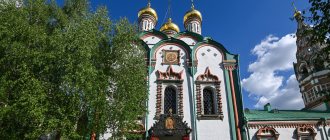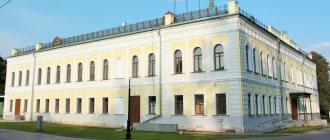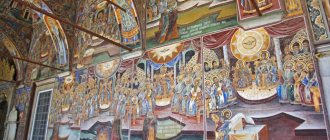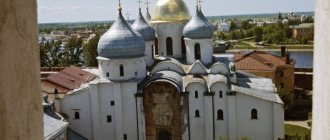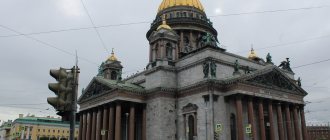Smolny Cathedral is one of the most beautiful cathedrals in the Northern capital. In addition to a number of exhibition palaces, St. Petersburg has other architectural pearls - tabernacles, temples, churches, cathedrals. Everything is ostentatious, pompous, because it once belonged to the capital of the empire. The Russian Empire was the largest in the world, but only a few cities can boast of its majesty.
Smolny Monastery is an Orthodox monastery located in St. Petersburg (Russia). The complex consists of several monastic buildings and the Church of the Resurrection of Christ, also called simply Smolny Cathedral (Smolny Temple). But the monastery never served its religious purpose.
History of the cathedral
The history of the monastery itself (as well as its name) is very interesting, similar to almost every building in St. Petersburg. Before the creation of the city, this area was a border region. In the village of Spasovshchina, immediately after the Swedes built the Nyenskan fortress on the opposite bank, the Sabina fortress was built on the site of the future monastery complex.
One of the first buildings of the developing city fortress was represented by the Admiralty Shipyard. It was for her needs that the Resin Yard was built. Subsequently, the Smolny Monastery was built, including a cathedral. As with the vast majority of famous buildings, its name contains an indication of location and part of the history.
In 1764, the Smolny Institute was opened in the monastery buildings - the first school in Russia for girls and a boarding school for noble maidens. From the October Revolution of 1917 to March 1918, the revolutionary government of Lenin was located in the monastery. In 1923, Soviet authorities closed the Smolny Cathedral. It was plundered and fell into disrepair. This period lasted until 1982, when the building was rebuilt into a concert hall. Other buildings are used by government agencies; part of the complex is occupied by St. Petersburg State University.
The construction of the complex was planned by Empress Elizabeth I. She chose Francesco Bartolomeo Rastrelli as the architect for its design. At the request of the Empress, both the golden domes of Moscow churches and the heavy forms of Italian Baroque architecture became his model. The first stone of the monastery was laid in 1748, rough construction was completed in 1757. The Smolny Cathedral itself was completed another 7 years later. Rastrelli also wanted to decorate the interior in Baroque style, but his plans were thwarted by the death of Elizabeth in 1762.
The construction of the cathedral also did not allow the end of the Seven Years' War, which began in 1757. During this period, work was suspended. Despite the unfinished construction, the Smolny Monastery remains (not only in terms of its unique design, but also in terms of implementation) one of the most important, integral works of Rastrelli, and is one of the most remarkable architectural ensembles of the 18th century.
After Elizabeth I, Catherine II, who had a different architectural taste, ascended the throne. The Russian architect Vasily Stasov was entrusted with completing the construction of the entire monastery complex. The floor plan of the Greek cross (including the interior in the classicist style) was taken as the basis. Work under his leadership was carried out in 1832-35.
Empress Catherine later donated the monastery to the city of St. Petersburg.
The greatest architect of St. Petersburg
Francesco Bartolomeo Rastrelli, son of the famous Carl Rastrelli, at that time served as the chief architect of St. Petersburg. He was entrusted with building the Novodevichy Resurrection Monastery. In 1744, the brilliant architect created a completely new version of the ritual object, which, together with the surrounding buildings, became a new phenomenon in the church.
Smolny Cathedral: an original approach to construction
The most important detail that distinguishes the complex from other similar structures is the complete absence of a surrounding stone wall. This indicated that the construction of an open monastic institution, completely separated from public life, was taking place. Rather, there was the construction of a higher educational institution for young women. The empress herself took part in the ceremony marking the laying of the first stone at the foundation of the future cathedral (1748). Subsequently, Rastrelli's Smolny Cathedral became one of the most important construction projects in the country.
But women's desires are changeable. And this applies primarily to the desires of monarchs. In this regard, in 1849 the original design of the cathedral was redone. In particular, the bell tower, designed by Rastrelli with a height of 140 m (hence exceeding the bell tower of Peter and Paul), was limited to more modest dimensions. In the new project, the features of ancient Russian monasteries were more visible. In particular, the presence of a dome was assumed: the central one - large, massive - was surrounded by 4 small domes.
Smolny Cathedral - the building of the century
Catherine II, who took Elizabeth's place in 1754, was shocked by the majesty and gigantism of the cathedral. But she ordered the replacement of the belfry, which overshadowed the Tsar Bell (its original dimensions were colossal - 6.5 meters wide). But the empress was not destined to live to see the solemn completion of the construction of the belfry. The construction of the monastery was forgotten.
Construction work has not been carried out for 7 years. The unfinished bell tower and some other parts of the building made the stucco complex a gloomy structure. During the war, the complex was partially destroyed. Catherine II replaced the architect working on the project. For 10 years, from 1785 to 1795, construction periodically stopped. If it were not for the need to build an educational institution for girls from aristocratic families, which would provide places to live, the Smolny Cathedral, like the entire monastery complex in the former northern capital, would have remained forgotten - at that time only 20 nuns lived in it.
Smolny Cathedral: completion of construction
The complete completion of the complex took place under Nicholas I. It lasted an incredible 87 years. Architect V.P. Stasov, who replaced Rastrelli, restored the cathedral over the course of 3 years. The consecration of the complex took place only in 1835. It became known as a monastic educational institution. Inspired by the external beauty of the Smolny Monastery, Russian craftsmen tried to make interior decorations worthy of the work of the great architect Rastrelli. The hall, decorated with marble, a crystal balustrade and an altar by A. Vasnetsov, made the Smolny Cathedral a unique treasure of Russian culture. The only part that was never completed was the bell tower, which, however, did not affect the majestic appearance of the temple.
Smolny Cathedral and modernity
But the complex did not always fulfill its original role as a monastery. During the revolutionary years, this pearl of Russian architecture was also used as a warehouse. The temple was closed and passed from hand to hand. In 1990, the building was used as a concert and exhibition hall.
The first prayer, after so many times not meeting its original purpose, was voiced here only in 2009. Since 2010, the cathedral has served its intended purpose - it is open for worship. In 2011, Christmas services were held in the church.
Concert hall
Since 1990, classical music concerts have regularly been held in the hall of the Smolny Cathedral. Since the next year, the cathedral has been the main concert venue for the Chamber Choir of the Smolny Cathedral. The hall's poster was constantly updated, the choir, under the direction of the Honored Artist of Russia - Vladimir Begletsov, performed Russian and Western European musical works.
After the transfer of the temple to the Russian Orthodox Church in 2015, the choir changed its name because it lost its base. Now it is called the Concert Choir of St. Petersburg and is located in the building of the City Duma.
© Tatyana Panova
What to see in the cathedral
Smolny Monastery is a St. Petersburg Orthodox convent. Its center is the Smolny Cathedral, dedicated to the Resurrection of Christ. The complex was built in the 18th century by the architect who designed the Winter Palace. The complex is characterized by a combination of golden domes, typical of Moscow churches, and Italian Baroque elements. It is this unusual combination, unique elements of interior and exterior decor that attracts most visitors.
The interior decoration was initially planned in the Baroque style, but was ultimately done in the Classicist style. The first school for girls in Russia was opened here (in 1764); in the winter after the October Revolution, Lenin’s revolutionary government was located in the complex. Today it is also used as a concert hall, a building for St. Petersburg University and government offices. The plan of the monastery shows the symbolism of the Roman cross.
Alexander Institute
The first name of the monastery was Voskresensky-Novodevichy (the consecration of the cathedral took place in 1748). Later the monastery began to be called only Smolny (for short). In 1765, the temple accepted its first students of noble birth, after which Empress Catherine decided to open another school for girls from a lower class (Alexandrovsky Institute). The building, designed by the architect J. Felten, bears the features of early classicism.
Smolny Institute
Another part of the complex that is worth the visitor’s attention is the Smolny Institute. This majestic classical building was designed in 1864 by another architect, J. Kvarneg. It was here that the St. Petersburg Council was located in 1917.
Concert hall
Unfortunately, after the revolution, the temple was looted, and the premises began to serve as a warehouse. In 1972, the iconostasis of the church was dismantled, and the concert and exhibition complex, opened later (1990), is located here to this day. Initially, classical music from various composers and the voices of the Stone Choir sounded in the concert hall. In 2015, after the temple was transferred to the jurisdiction of the Russian Orthodox Church, the choir moved to the City Duma.
Today, the concert and exhibition hall hosts exhibitions of works by various artists and cultural events.
Belfry of Smolny Cathedral
One of the elements of the complex most visited by guests is the belfry with the highest observation deck in the city (50 m). To get to the platform, you need to walk up about 300 steps of a regular staircase, followed by a narrower spiral staircase. But the effort is worth it - the observation deck offers a beautiful view of St. Petersburg. Of particular note are the Church of St. Zechariah and Elizabeth, b. Neva, Bolsheokhtinsky bridge.
A special feature of the observation deck is the opportunity to listen to an approximately 20-minute audio tour.
Near the dome there is an attic space, also worth attention. It serves as a transition between belfries. The attic, unlike most other parts of the temple, was not affected by restoration, thanks to which it retained its original architectural features.
Smolny Cathedral: interior and exterior
Smolny Cathedral, glorifying St. Petersburg, which combines white stone decoration and sky blue walls, is surrounded by four corner churches. Nearby there are residential monastery complexes decorated with two-story arcades.
In accordance with the original initial design, the Smolny Cathedral of the architect Bartolomeo Rastrelli was supposed to look like a massive one-story temple (in the style of European churches). But this design was not approved by Empress Elizabeth, who wanted to build a more magnificent building. The temple itself has only one dome (central); the remaining four domes make up the bell tower and have a concave shape.
The open fence of the church, built in accordance with the design of the architect V. Stasov, still retains the status of the most outstanding works of architecture and art in St. Petersburg.
Visitors' attention is also attracted by the handmade interior design, also designed by the famous architect of his time V. Stasov. The final interior decoration turned out to be both majestic and simple. The huge cathedral hall with three iconostases is decorated with marble decoration; in front of the altar there is a unique crystal balustrade. It is also worth paying attention to the original carved details. Of the many previously present relics in the church, the icons “Introduction of the Virgin Mary” and “Resurrection of the Cross” (A. Venetsianov) have been preserved.
Architecture Features
The height of the cathedral reaches 94 meters. Smolny Cathedral is made in the Baroque style, has pediments and lucarnes. If you look at the monastery from above, it is built in the form of a Greek cross (Smolny Cathedral in the center and 4 churches in the corners).
The five-domed structure of the cathedral is of great interest. Rastrelli wanted to build a single-domed cathedral, however, Elizaveta Petrovna insisted on five domes. The famous master designed the domes of the cathedral in such a way that if you look at the cathedral from afar, it creates the illusion that it is huge. However, if you come closer, the building seems to shrink, but does not lose its beauty and grandeur.
© Tatyana Panova
How to get to the cathedral
Smolny Temple is located about half an hour’s walk from Chernyshevskaya metro station. Therefore, it is advisable for visitors to take buses No. 46 or No. 22, or trolleybus No. 15, the route of which passes directly in front of the temple. From the Ploshchad Vosstaniya metro station, bus No. 22, trolleybuses No. 5 and No. 7 go to the complex.
Smolny Cathedral is one of the monuments of world significance. Today's complex has been given the status of a branch of the State Museum "St. Isaac's Cathedral". It is a venue for concerts, graphics and painting exhibitions. The majestic building is open to tourists, connoisseurs and simply connoisseurs of culture.
Tourists in the cathedral (as well as in a wide range of other churches) are not held in high esteem - photography and video filming are prohibited here, and the guards are uncompromising in this regard. This is not surprising, because faith cannot be captured in a photograph. Also, when visiting the complex, it is important to pay attention to the required dress code: visiting men must be without a headdress, women must have their heads covered. Shorts and short skirts are not allowed.
Opening hours of the Smolny Cathedral
Since 2015, the cathedral has been an active Orthodox church. Divine services are held there daily. You can visit the cathedral from 07.00 to 20.00.
Schedule of services at the Smolny Cathedral in St. Petersburg:
- 07.00 and 09.30 - two Divine Liturgies (on Sundays, holidays);
- 08.40 — Divine Liturgy (daily);
- 14.00 - prayer service;
- 16.00 - memorial service;
- 18.00 - evening service.
Interior of Smolny Cathedral:
Prices for excursions to the Smolny Cathedral in 2021
You can visit the temple with a tour from Thursday to Sunday at 12.00, 13.00, 14.30 and 16.00. You can also book a tour for another day by prior arrangement.
Cost of excursion services: excursion - 200 rubles, climb to the belfry (observation platform) - 150 rubles. Free for students and pensioners.
In addition to excursions, the cathedral hosts educational quests (200 rubles per person):
- “Back to the Future” (10+) - for a group of up to 35 people;
- “Secrets of the Smolny Cathedral” (for children 5–12 years old) - for groups of up to 10 people.
Detailed information about quests can be found by phone or email [email protected]
© Natalia Semchina

